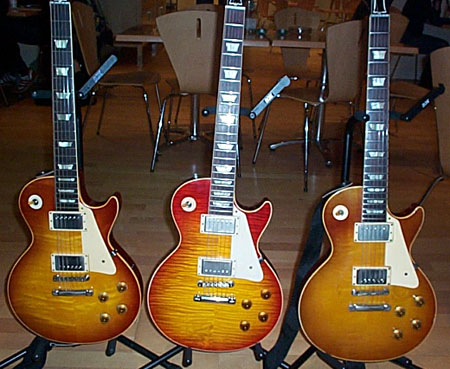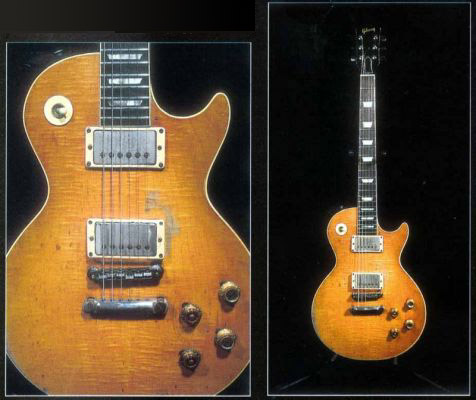Have you ever wondered why Mark Knopfler’s Gibson Les Pauls (he has a ’58, a ’59, and some replicas of late 50ies models) differ so much in their colour? And what is the colour called, simply sunburst, or is it cherry sunburst, or tobacco sunburst? Have you ever heard the term ‘unburst’?

The answer is simple: all those Les Paul Standards from that era (they were only built in this version from ’58 to ’60) were cherry sunburst, a sunburst which goes from red on the outer area to yellow in the center. However, the red paint Gibson used in those days was very sensitive to light exposure (especially UV radiation) and easily faded. This is a general problem of red, but it depends of the kind of laquer to which extend this might happen. Modern laquer is almost stable in this respect, but the laquer on the early Les Pauls has proven to be extremely sensitive, much more than the one of Fenders from that time.
While there are old Les Pauls Standards that look like new – which means a bright red -, there are others which have lost all the red and seem to be completely yellow. These got the nickname ‘unburst’ – Peter Green’s Les Paul from the Fleetwood Mac days (later this guitar belong to Gary Moore who meanwhile sold it) is maybe the most famous example of these.


6 thoughts on “Sunburst and unburst Les Pauls from the late 50ies”
I first thought Knopfler’s reissue (center on picture) was the 1984 he played in the BIQ era, but it isn’t (I compared the flame grain). Does anyone know what year it is? I think I read something but cannote remember.
Ingo .. I think that one appeared around 2005 – it’s very close to one that appeared on a stand with other guitars before the show. It’s certainly not the one that appeared during the 1985-6 tour with his birth date as serial number or as you say the first 84 one. Just to add Neil dorfsman mentioned Money For Nothing been played on a Les Paul Junior when we all thought it was the 1984 LP .. he proberly meant the Les Paul Special as that always seemed to be a favourite studio guitar.
Hello Ingo. Thanks for your blog and old website. But now I’m trying to make a update of our guitars section at our website and I had my “private investigation” about Mark’s Les Paul. There are a lot wrong information. A lot of it cames from Guitar & Styles book. Actually Mark has 4 Gibson LP guitars: 2 original guitars ’58 & ’59 and 2 re-ussues: first has s/n 90006. The wrong info that this guitar produced in 1984. It is mystake. If you are trying to decode the s/n in accordance with Gibson Blue Book, you can find that the first digit “9” means year of production so 90006 is sitxth guitar was produced in 1979 (not in 1989, Mark got it from Rudy Pensa in 1984) Second re-issue was buil by Gibson Custom Shop with Mark’s birthdate as the serial number – 12849. Mark told about it in his old interview for Vintage guitar mazagine in 2001. But there is not any info – when and where Mark can use this guitar.
OK – let me correct the date for #9 0006. I’ve also emailed to Stanislav’s website. It’s not an ’84 or a ’79 – it’s an ’83. Gibson first “officially” started making LP reissues in 1983 (before this they had made special reissue runs for different music stores – Strings and Things, Leo’s, Guitar Trader). The Gibson reissues were officially named the Flametop ’59 Reissue. The very first run of them had serial numbers coded “9 xxxx” and after that they switched to a “Y xxxx” format, with Y being equal to the last character of the year produced. So, to be an ’84, it would be 4 xxxx. I own #9 0004 and it dates to about the second week of June, 1983, and has been verified by Gibson. I hope this helps correct a common misconception about Mark’s #9 0006.